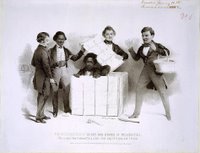Celebrating the people and events of Black History in America
Friday, October 27, 2006
Sarah Parker Redmond's Unusual Life
Wednesday, October 25, 2006
Harriet Tubman Implements Strategies on the Underground Railround
Tuesday, October 24, 2006
Abolitionist Harriet Jacobs publishes account of slave experiences
Monday, October 23, 2006
Sojourner Truth Brings Court Case to Free Son

Famed abolitionist Sojourner Truth, with the help of the Quakers, sued to free her son Peter who had been illegally sold into slavery. Peter was to be emancipated under the law of his state of residence (New York). Instead the 5-year-old was sold to an Alabama owner. The court process took several months, but Truth prevailed and Peter was returned to her.
New feature: Theme of the Week
Friday, October 20, 2006
Senator Blanche K. Bruce
Thursday, October 19, 2006
Many African-Americans Enlist in the Union Army
Source: From Slavery to Freedom
Wednesday, October 18, 2006
Henry "Box" Brown's Unique Escape from Slavery
Tuesday, October 17, 2006
Black Poetry Day honors birth of poet Jupiter Hammon
Monday, October 16, 2006
Chicago names school for native daughter
Friday, October 13, 2006
Fruit of the Orchard: Environmental Justice in East Texas
This post originally appeared in the blog of the African American Environmentalist Association (http://aaenvironment.blogspot.com/).
The book Fruit of the Orchard: Environmental Justice in East Texas is a story about injustice in Winona, Texas. Excerpts: In 1982, a toxic waste facility opened in the Piney Woods in Winona, Texas. Soon after the plant opened residents started noticing huge orange clouds rising from the facility and an increase in rates of cancer and birth defects in both humans and animals. The company dismissed their concerns, and confusion about what chemicals it accepted made investigations difficult. Outraged by what she saw, Phyllis Glazer founded Mothers Organized to Stop Environmental Sins (MOSES) and worked tirelessly to publicize the problems in Winona. The plant finally closed in 1998, citing the negative publicity generated by the group.
This book originated in 1994 when Cromer-Campbell was asked by Phyllis Glazer to produce a photograph for a poster about the campaign. In the accompanying essays, Phyllis Glazer describes the history of Winona and the fight against the facility; Roy Flukinger discusses Cromer-Campbell's striking photographic technique; Eugene Hargrove explores issues of environmental justice; and Marvin Legator elaborates on how industry and government discourage victims of chemical exposure from seeking or obtaining relief.
Thursday, October 12, 2006
Professor Lois Mailou Jones Trains Generations of Artists
source: Howard Magazine
Wednesday, October 11, 2006
Historian John Hope Franklin Publishes Landmark Book
Tuesday, October 10, 2006
Arthur Ashe Takes a Stand Against South African Apartheid
Friday, October 06, 2006
The 54th Massachusetts Regiment
source: americaslibrary.gov
Thursday, October 05, 2006
Nurse Harriet Tubman
Source: americaslibrary.gov
Wednesday, October 04, 2006
Photographer Gordon Parks
Renaissance man Gordon Parks, the first African-American photographer for Life magazine, taught himself the craft of photography. Arguably his best known photograph is American Gothic, a portrait of cleaning lady Ella Watson holding a broom and a mop in front of the American flag.
Tuesday, October 03, 2006
Political Pro: Hiram R. Revels
Source: Britannica.com
